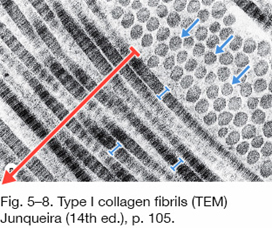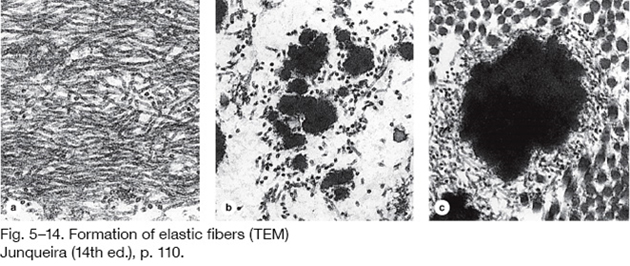|
Fibers of connective tissues
Recall that CT is composed of cells and extracellular matrix (ECM),
with the latter being its major constituent. Two major components of
the ECM are protein fibers and ground substance, with the three
principal fibers being reticular, collagen, and elastic. Here we
will look more closely at collagen and elastic fibers.
 Collagen Collagen
Eosin effectively stains type I collagen, and this accounts for the
bundle staining observed in most H&E sections. However, fibrillar
collagens have a unique structure that can be observed in the EM.
High magnification TEM shows individual collagen fibrils and their
characteristic banding pattern when cut longitudinally (blue bars in
image). The alternating light and dark regions represent the overlap
and gap regions of the highly organized collagen molecules that
self-assemble to form a fibril. The blue arrows indicate cross
sections of fibrils, and the individual dots within the circular
fibril are individual collagen triple helices. The red line
indicates a grouping of fibrils called a fiber.
Elastic Fibers
The following series of TEMs illustrate elastic fiber assembly: (a)
Shows microfibrils (fibrillin) which are secreted by fibroblasts
(and smooth muscle cells) and forms a scaffold. (b) Next, elastin
(dark amorphous material) is secreted and aggregates on the
microfibrils. (c) The mature elastic fiber has elastin aggregated in
the middle and microfibrils surrounding it.

Elastic fibers have a high concentration of glycosylated amino acid
residues and generally don’t stain well with H&E in the light
microscope. Typically, elastic fibers are visualized with
specialized stains such as aldehyde fuchsin. Now look for elastic
fibers in the tunica media (middle layer) of these two slides (sample
1 and sample 2).
On the connective tissue
slide showing small arteries and veins, examine the internal and
external elastic laminae on either side of the tunica media.
Try this self-assessment
quiz.
Next is nervous
tissue. |